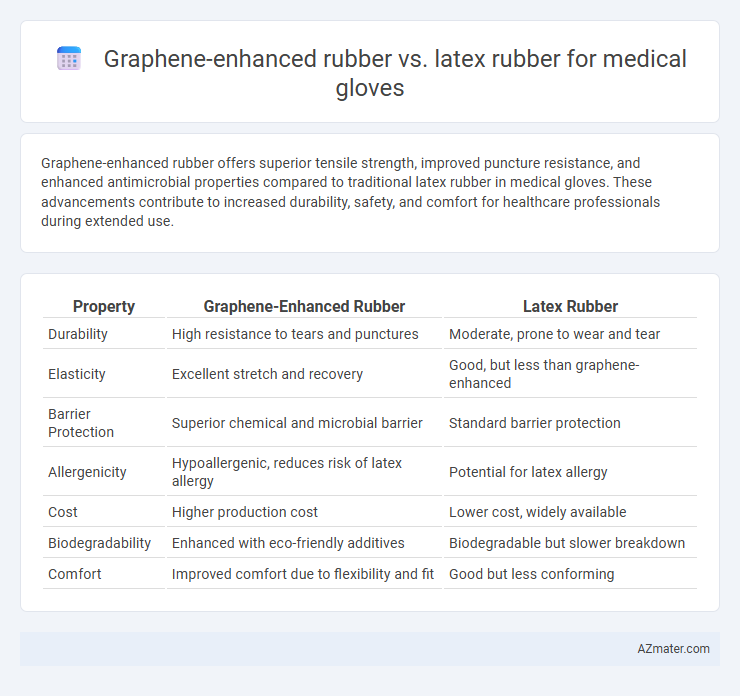Graphene-enhanced rubber offers superior tensile strength, improved puncture resistance, and enhanced antimicrobial properties compared to traditional latex rubber in medical gloves. These advancements contribute to increased durability, safety, and comfort for healthcare professionals during extended use.
Table of Comparison
| Property | Graphene-Enhanced Rubber | Latex Rubber |
|---|---|---|
| Durability | High resistance to tears and punctures | Moderate, prone to wear and tear |
| Elasticity | Excellent stretch and recovery | Good, but less than graphene-enhanced |
| Barrier Protection | Superior chemical and microbial barrier | Standard barrier protection |
| Allergenicity | Hypoallergenic, reduces risk of latex allergy | Potential for latex allergy |
| Cost | Higher production cost | Lower cost, widely available |
| Biodegradability | Enhanced with eco-friendly additives | Biodegradable but slower breakdown |
| Comfort | Improved comfort due to flexibility and fit | Good but less conforming |
Introduction to Medical Glove Materials
Graphene-enhanced rubber and latex rubber are key materials used in manufacturing medical gloves, each offering distinct benefits. Graphene-enhanced rubber incorporates graphene to improve durability, flexibility, and antimicrobial properties, while traditional latex rubber is valued for its natural elasticity, softness, and barrier protection. Understanding the material properties of graphene-enhanced and latex rubber is essential for selecting gloves that maximize comfort, protection, and performance in medical settings.
What is Graphene-Enhanced Rubber?
Graphene-enhanced rubber incorporates graphene nanosheets into the rubber matrix to significantly improve mechanical strength, elasticity, and antibacterial properties compared to traditional latex rubber. This advanced composite material offers enhanced puncture resistance and durability while maintaining flexibility, crucial for medical glove performance. Graphene's exceptional conductivity and antimicrobial qualities also contribute to better protection against pathogens and reduced risk of contamination in medical settings.
Overview of Latex Rubber in Medical Gloves
Latex rubber, derived from natural rubber latex harvested from Hevea brasiliensis trees, remains the predominant material for medical gloves due to its superior elasticity, comfort, and tactile sensitivity. It offers excellent barrier protection against pathogens and biological contaminants, making it essential in healthcare settings. Despite its benefits, latex can cause allergic reactions in some users, prompting the search for alternative materials like graphene-enhanced rubber for improved performance and safety.
Material Properties: Graphene-Enhanced vs Latex Rubber
Graphene-enhanced rubber offers superior mechanical strength, elasticity, and thermal conductivity compared to traditional latex rubber, resulting in enhanced durability and tactile sensitivity in medical gloves. The integration of graphene improves puncture resistance and chemical stability, crucial for sterile and high-risk medical environments, while maintaining the flexibility essential for precise hand movements. Latex rubber, although naturally elastic and cost-effective, lacks the advanced mechanical resilience and barrier properties provided by graphene-enhanced composites, making it less optimal for extended or high-performance medical applications.
Barrier Protection and Puncture Resistance
Graphene-enhanced rubber offers superior barrier protection and puncture resistance compared to traditional latex rubber in medical gloves due to graphene's exceptional strength and impermeability at the molecular level. This material significantly reduces the risk of microbial penetration and physical punctures, making it ideal for high-risk medical environments. Moreover, graphene's integration enhances glove durability and longevity without compromising flexibility or comfort essential for medical procedures.
Comfort and Fit Comparison
Graphene-enhanced rubber offers superior elasticity and tensile strength, resulting in a more precise fit and reduced hand fatigue compared to traditional latex rubber. The enhanced breathability and moisture-wicking properties of graphene composites improve overall comfort during extended use. In contrast, latex rubber provides good flexibility but often lacks the adaptive fit and temperature regulation benefits seen in graphene-infused gloves.
Allergenicity and Skin Sensitivity
Graphene-enhanced rubber offers a significant reduction in allergenicity compared to traditional latex rubber, minimizing the risk of Type I hypersensitivity reactions caused by natural latex proteins. Its biocompatible properties enhance skin tolerance, reducing irritation and sensitivity commonly associated with latex gloves. This makes graphene-infused gloves a safer alternative for healthcare workers and patients with latex allergies or sensitive skin types.
Cost and Manufacturing Considerations
Graphene-enhanced rubber offers improved durability and tear resistance compared to traditional latex rubber, potentially reducing glove replacement frequency and overall costs in medical settings. Manufacturing graphene-infused gloves requires advanced technology and higher initial investment, leading to increased production expenses relative to latex gloves. Despite higher upfront costs, the enhanced performance and longevity of graphene-enhanced gloves can justify their price for specialized medical applications.
Environmental Impact and Sustainability
Graphene-enhanced rubber in medical gloves offers improved durability and biodegradability, reducing environmental waste compared to traditional latex rubber. Latex gloves, while naturally derived from rubber trees, often involve deforestation and allergic reactions that limit their sustainability and usability. Incorporating graphene not only extends glove lifespan but also promotes eco-friendly disposal, aligning with sustainable medical practices.
Future Trends in Medical Glove Technology
Graphene-enhanced rubber offers superior tensile strength, antimicrobial properties, and enhanced flexibility compared to traditional latex rubber, positioning it as a transformative material in medical glove technology. Innovations are driving the integration of graphene to improve durability and reduce allergies associated with latex, supporting safer and more effective healthcare practices. Future trends emphasize sustainable production, nanomaterial integration, and customized glove formulations to meet evolving medical standards and user needs.

Infographic: Graphene-enhanced rubber vs Latex rubber for Medical glove
 azmater.com
azmater.com